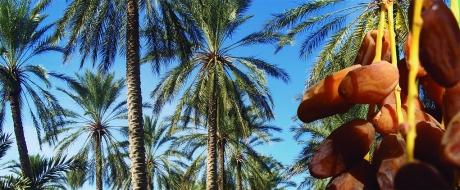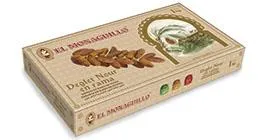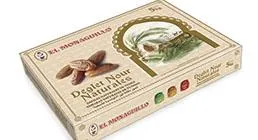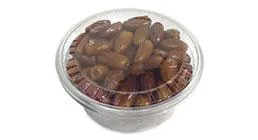The fruit bunches are harvested from the ground, with short ladders, when the palms are young and, thereafter, when the palms are 10 to 15 years old, with stairs or platforms permanently attached to the trunks.
Throughout their training, which amounts to about 5-6 months, the date goes through 4 stages or ages whose names are: Kimri, Khalal, Rutab and Tamar.
A small quantity of dates is harvested in step "Khalal" (partial maturity) that are yellow or red (depending on the grower), but there are many consumers who consider astringent (high tannin content). Most dates are harvested at full maturity stages "Rutab" and "Tamar", which have higher sugar content, lower humidity, lower in tannins and are softer than the "Khalal" age.
Due to its wide range of types, dates are classified as soft (eg Barhee, Halawy, Khadrawy, Medjool), semi-dry (eg Dayri, Deglet Nour, Zahidi) and dry (eg Thoory). The type of fruit depends on their content of glucose, fructose and sucrose.
The Deglet Nour (in Arabic دقلة نور), meaning "finger of light" refers to one of the 300 varieties available dates. It is said of him that he is the "king of dates" or "a miniature sun" for its golden, translucent and shiny color, and sweet and slightly sweet flavor.
Etymologically, the word deglet comes from Dejla, which is the Arabic name of the Tigris River in Iraq. This variety would have been imported, centuries ago, from this region.
This variety is grown mainly in Algeria (in the Zibans region near Biskra), Tunisia and the arid southwestern states of the United States (California, Arizona and Texas), where the climate is similar to North Africa.
According to the Groupement interprofessionnel des fruits tunisiens, Tunisia would be the largest exporter of Deglet Nour, while Algeria would be the leading producer of this variety.
The Dátil Medjool has been called the "king of dates" and "jewel in the crown of dates". It is the largest, has a fine texture similar to that of a toffee candy, taste great and is very sweet. In antiquity it was carefully cultivated by the people of Morocco to flatter the Arab sheiks and their families, those who cataloged this variety as the most delicious of all dates.
The Halawy is an elongated date to which the bone is removed to place inside a walnut. It is called "dromedary date".
The Khadrawy is a round, luscious, fleshy, soft, damp date.
The Zahidi is a small date which is secured tightly to the stalk.
The Dayri Date has a dark brown leather and caramel flavor.
The Barhee variety is pretty sweet and it is cut into pieces. The Lebanese use it to cook with meat.
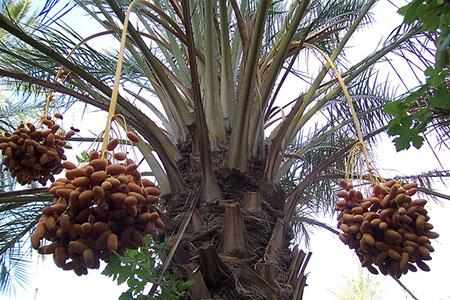
Dates can be eaten fresh or dried and are a staple food for the inhabitants of Northern of Africa and the Near East, who are the main producers. They contain a great nutritional value which lies in its sugar content, up to 70%, very easy to assimilate. They are very nutritious for its high carbohydrate, iron, potassium, phosphorus, vitamins A and B, thiamine, riboflavin, niacin, tryptophane and ascorbic acid.
In North America, dates are associated with sweet foods and in Arab countries they are stuffed with other fruits, preserved in different ways, distilled,... and are consumed in salads and couscous. In India they are used for chutneys and curries. In the oasis of the Sahara and other North African, cakes of dates are made intending to supply food to caravans through the desert. In the Middle East, palm wine or toddy is made by fermenting the sugary sap extracted from the crown of the date palm.
Dried dates are stored in a cool dry place for several months, even more than a year. Soft varieties are preserved over two weeks in the refrigerator. The optimum relative humidity of the fruit is between 70-75%.






